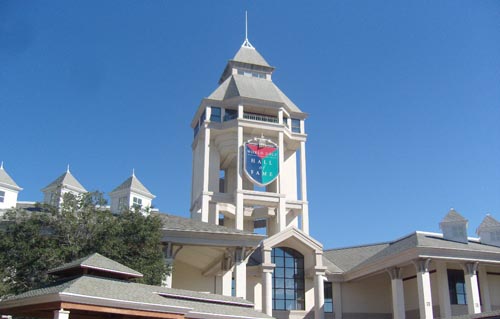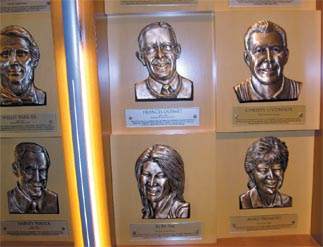A new home for golf’s greats

The World Golf Village in St. Augustine, Florida, is home to the Hall of Fame, pictured, as well as two golf courses and a golf academy.
The greatest players in the sport are honored here, with over 2,000 pieces of personal memorabilia along with videos and photos. The village is supported by a consortium of 26 golf organizations from all over the world, reflected in a row of flags at the entrance, including a Korean one raised by pro Pak Se-ri.

Pak Se-ri’s locker at the hall of fame includes commemorative photographs and her trophy from the 1998 U.S. Women’s Open.
However, after her induction, whether golfers belong in the hall of fame has become an issue. “We’re trying to change the criteria for the LPGA Point System,” said a spokesperson at the Hall of Fame. “An athlete would have to be an active LPGA Tour member for 10 years in this category, but we’re trying to change it to the same as the men’s PGA Tour Ballot, which requires the inductee to be a minimum of 40 years old.”

The faces of golf’s greats line the Wall of Fame.
The World Golf Hall of Fame was originally located in Pinehurst, North Carolina, where it opened in 1974 with a class of 13 members, but the PGA took over management in 1983. The new site in St. Augustine opened in 1998, and the LPGA Tour Hall of Fame in Georgia merged with it the same year.
Also in the hall of fame are famous golf aficionados such as Bob Hope, whose plaque reads, “Not a golf champion, but a great champion of golf.”
Hope played with the top professionals, caddies, celebrities, generals and sometimes even presidents such as Gerald Ford, George H. W. Bush and Bill Clinton. The exhibition “Bob Hope: Shanks for the Memory” displays the largest collection of his golf memorabilia.
Visitors can follow in the footsteps of Bobby Jones and Ben Hogan on the “Wall of Fame,” where plaques of all the inductees’ embossed faces hang along the wall.
One of the highlights at the Hall of Fame is the members’ locker room. Golf clubs and trophies adorn every corner. In Payne Stewart’s locker are a golf club, his trademark flat cap and his harmonica. Tom Kite’s locker showcases his golf bag and clubs he used during the 1992 U.S. Open. In the locker of the first African-American to play in the PGA and to be inducted into the Hall of Fame, Charlie Sifford, sits his PGA membership card, a winning scorecard and his favorite brand of cigars. The most successful amateur golfer in Canadian history, Marlene Stewart Streit, donated her knitting needles and the clubs she bought with the money she saved up working as a caddy.
In Pak’s locker is a photo of her holding up the trophy she won at the 1998 U.S. Women’s Open. The words “Se-ri Pak will always be remembered as one of golf’s most important pioneers” are written on the wall. Her win at the 1998 U.S. Women’s Open inspired the wave of Koreans who have since ranked at the top of the LPGA. There is also an explanation as to why the romanization of Pak’s name is Pak instead of Pak. Apparently, when she was getting her passport, she forgot to write the “r,” but realized this made her name look unique.
Other facilities include the 2,700-square-foot PGA Tour Golf Academy, which offers classes, private lessons and player development programs.
By Sung Ho-jun [estyle@joongang.co.kr]










with the Korea JoongAng Daily
To write comments, please log in to one of the accounts.
Standards Board Policy (0/250자)